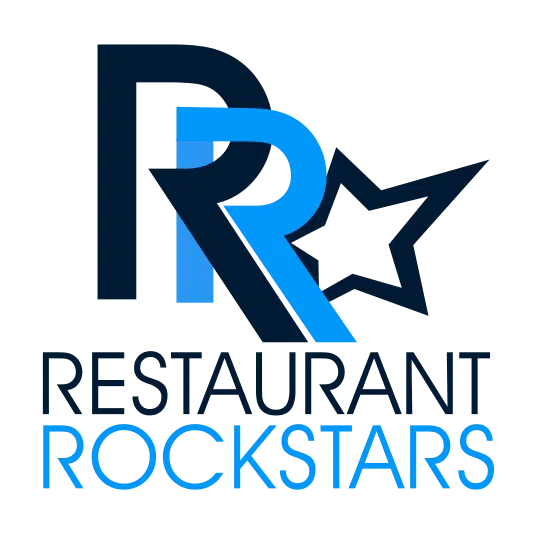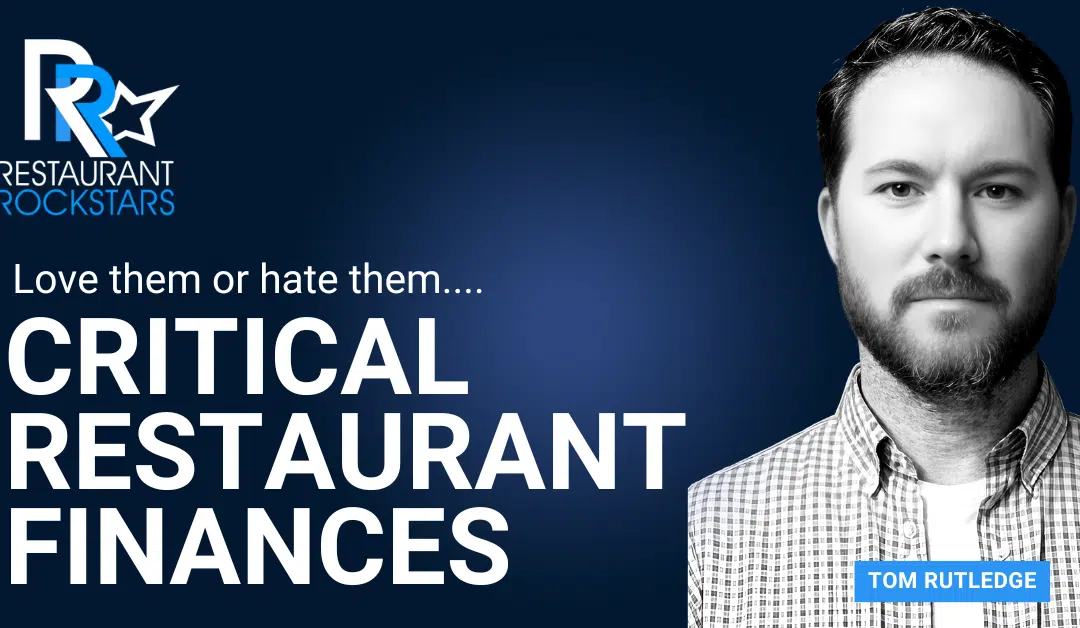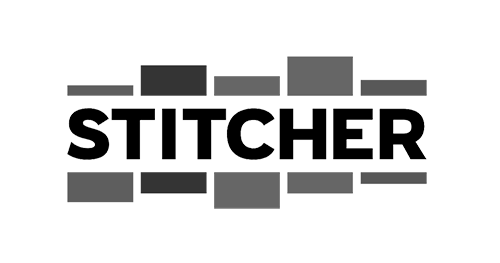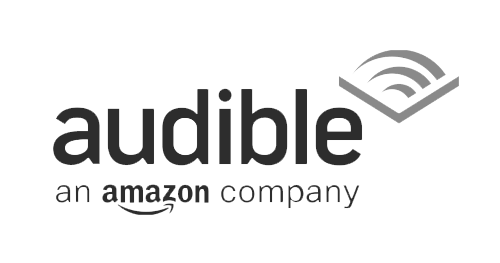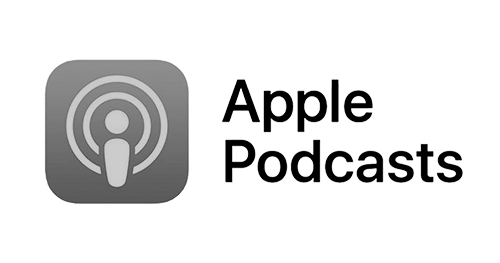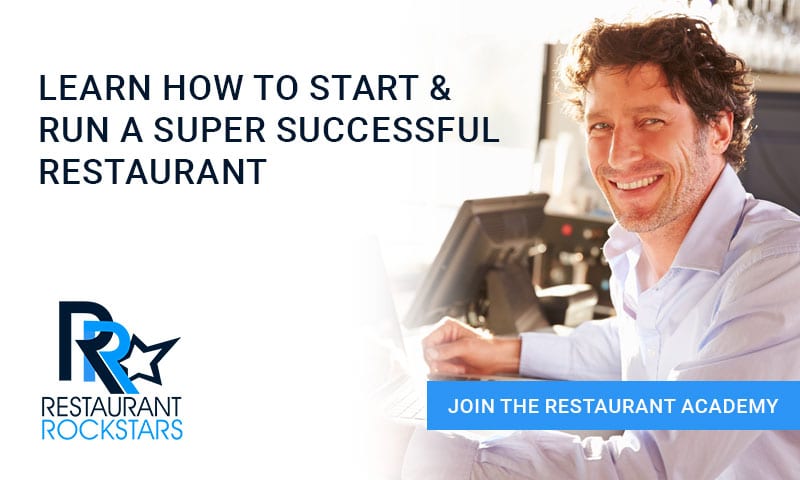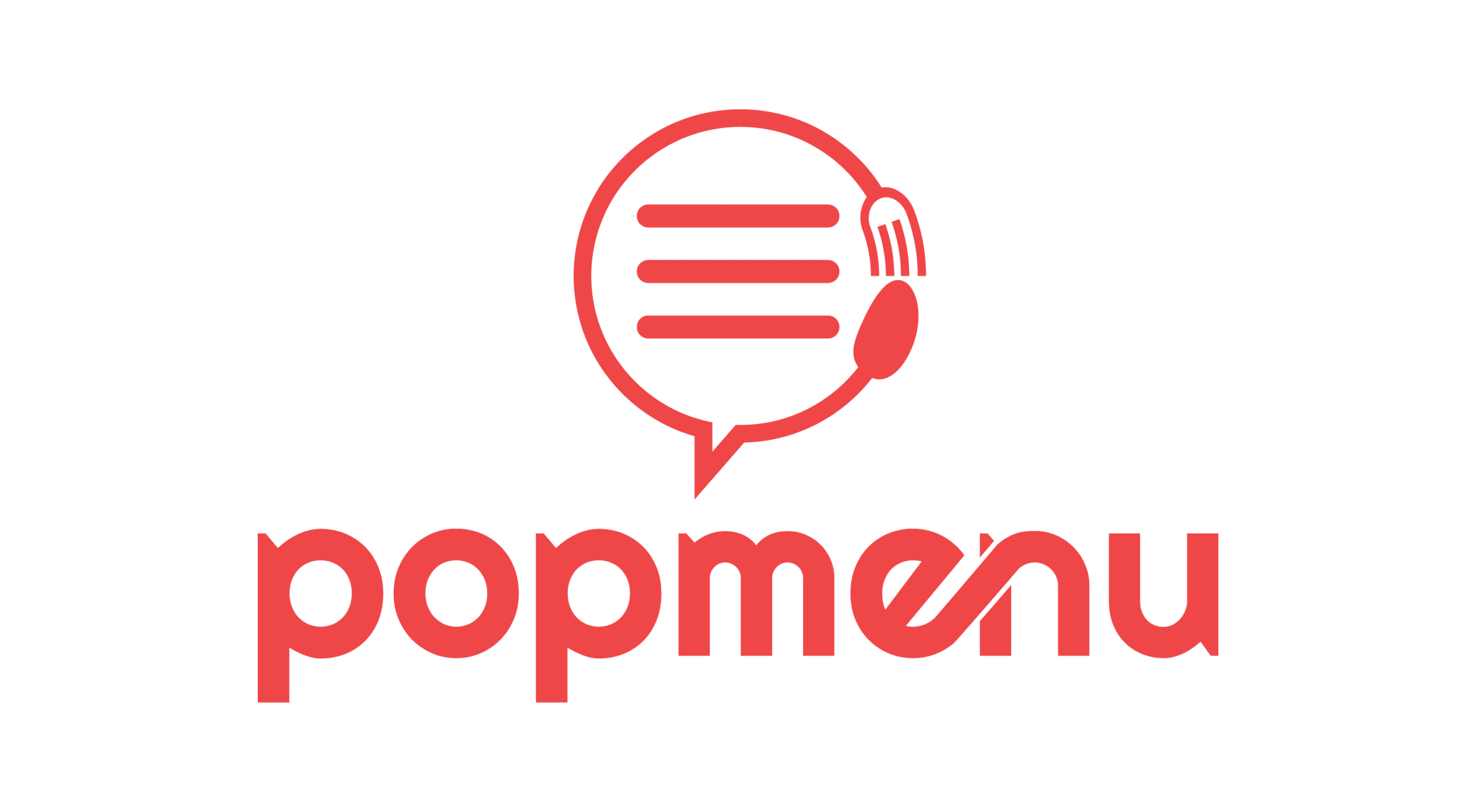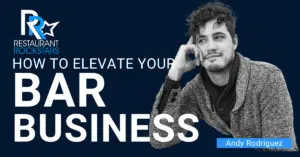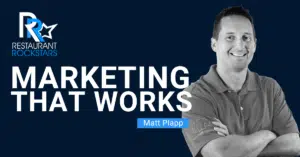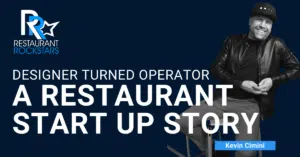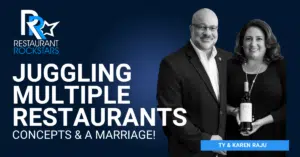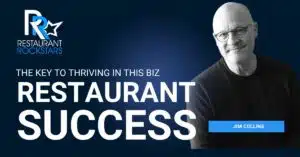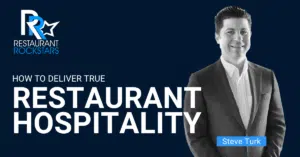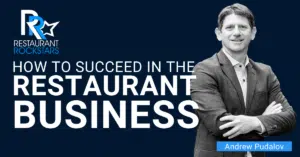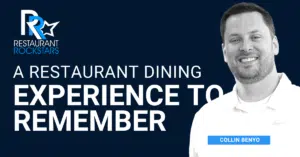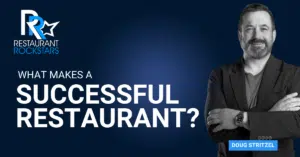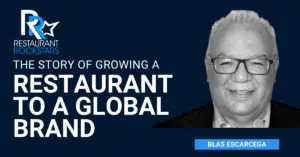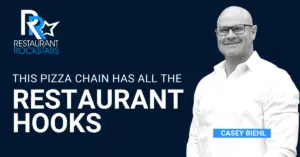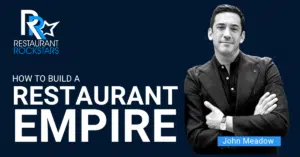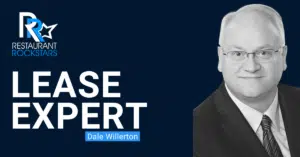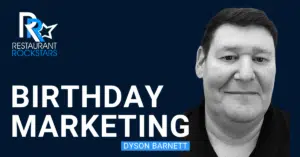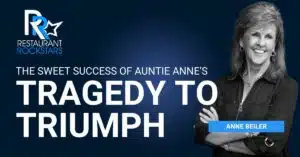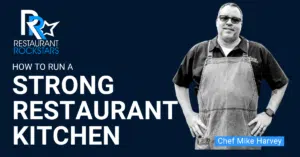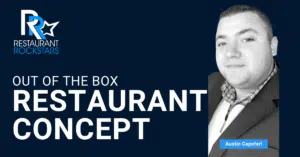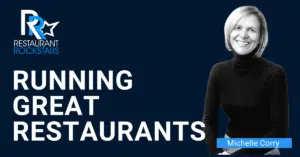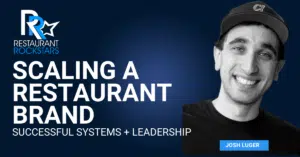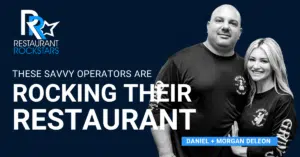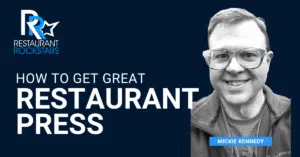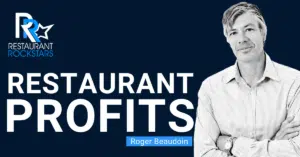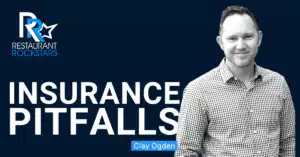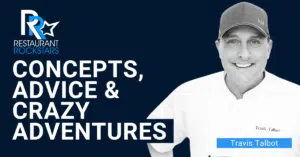Restaurant Rockstars Episode 371
Restaurant Finances that are VITAL to your Success
LISTEN HERE OR ON YOUR FAVORITE PODCAST PLAYER
I get it, many operators hate numbers, so they avoid them.
But the truth is numbers really move the needle good or bad, and they ultimately determine your restaurant’s success or failure.
When I owned restaurants, I was obsessed with my critical numbers and analyzed them each and every week. It’s one of the reasons my restaurants had more than double the net profit of the average full serve restaurant. With the right approach, you can too!
In this episode of the Restaurant Rockstars Podcast, I’m speaking with Tom Rutledge, Founder and Managing Member of RDMS Group, restaurant finance guru and game-changer with expertise in payroll, food costing, labor analysis, budgeting, COGS trending, and financial viability.
Listen as Tom tells:
- The vital financial foundation your restaurant needs.
- What restaurants need to do now to move forward post-pandemic?
- How to deal with inflation and the labor crisis
- The importance of maintaining margins despite rising costs
- His best advice on inventory & prime cost
- What to do about labor cost abuses
And a key-takeaway, changing the mindset of running a restaurant to running a business.
Don’t miss this episode, then go out there and Rock YOUR Restaurant!
Roger
Connect with our guest:
Welcome back. And thanks for joining me on the Restaurant Rockstars podcast. My guest this week, Tom Rutledge is a restaurant finance guru, we covered so much information that’s critical to profitable operation of your business. We talked about prime costs. We talked about inventory. We talked about abuses, labor costs, raising prices, all the critical things, menu costing, and staying on top of where your restaurant is making money and where you could be losing money.
So much valuable advice here. As long as we’re talking about finances., that is a system among many systems. I want you to know that the Restaurant Rockstars Academy is a series that zeros in on. cost controls and how to maximize profit. But we also train your team on leadership and accountability.
We talked about that as well in today’s episode, as well as staff training for service and salesmanship and check averages, also marketing that’s proven and trackable. All these are in the Academy. And best of all, you can give access to up to 25 people now for free in your organization so that they learn your business and they learn to run.
Your business is if they owned it again at the restaurant Rockstars Academy. Thanks to our sponsors this week. Now on with the episode.
You’re tuned in to the Restaurant Rockstars Podcast. Powerful ideas to rock your restaurant. Here’s your host, Roger Beaudoin.
rockstars, the busiest time of the year is coming. Is your staff ready for the holiday rush?, this year, give your team the gift of Popmenu AI Answering, a simple solution for phones ringing off the hook. AI Answering handles calls 24 7, 365 days a year, so your staff can focus on in person guests.
Customize your greetings and responses. Answer common questions. Promote specials and events and send follow up links to ordering and reservations. AI answering handles it all, while escalating more complex conversations back to your team. Now, never miss another tasty revenue opportunity. PopMenu is the marketing technology platform designed to make growing your restaurant Discover more AI restaurant tools that turn your to do list into an already done list.
Request a demo today and my listeners for a limited time will get $100 off their first month, plus lock in one unchanging monthly rate. Go now to popmenu.com/rockstars. Again, get $100 off your first month at popmenu.com/rockstars
Listen from one restaurateur to another, and I hope you GMs out there listening as well are paying attention. , marketing should never be an experiment. Oh, I tried this, or I tried that. No. Any of your valuable dollars that you spend on marketing should absolutely be trackable. You should know exactly.
Where the business is coming from and that it’s driving return On your investment, you spend a certain amount of money, you wanna make far more money in return from that marketing if you can track it. So pay attention. My friend Dyson runs a business called The Birthday Club and his program is done for you because we know that everybody dines out on their birthday.
It’s a tradition, it’s a celebration. But not only do they not come in by themselves, they bring many friends with them. They usually have free spending and large check averages. It’s very profitable business. So why leave it to Chance? Why let your competitors get all the birthday business? So again, the Birthday Club is a done for you program.
All you have to do is check out www.jointhebirthdayclub.com/birthdayRockstar. It’s a great program. If I still owned and operated restaurants today, after decades, it’s something I would definitely be doing, it’s worth checking out. Www.jointhebirthdayclub.com/birthdayRockstar
Tom, how are you today? Welcome to the show. Glad to have you. Roger, doing great. Thanks for having me. Really excited. , I am so obsessed, even to this day, like I started restaurants from scratch and finances were critically important to my success. It’s one of those foundational systems that every restaurant owner, operator, GM really needs to understand and, , monitor and put in place and then execute.
And you’re a financial guru in this area. So before we kind of get into that, tell us about your story in hospitality. How’d you get here? Sure, I come from a finance family. So we were all more than New York Wall Street kind of types, if you will, um, in the extended family. And that was definitely what I went to school for.
That was the expectation. That was frankly, my expectation. I started getting those internships at all those big firms and realize this is absolutely. Not for me. Um, I love the thought process behind it, but I couldn’t do it every day Without it being passionate about where I was. So I had what I refer to as my early life crisis I got out of school had that job was in finance doing the whole thing and then realized yeah This truly isn’t my life goal.
I packed everything up Moved to San Francisco and went to culinary school and just dove headfirst that way. Awesome. Um, yeah, I figured, you know, I, I knew in my heart of hearts that I wasn’t going to be the next big chef, but I figured I need to learn and education was important to me. So I, I went that way first, uh, while doing that, I was cooking throughout kitchens that only reemphasized the fact that.
I didn’t belong with a pan in my hand full time. It was, it was not my skillset. My wonderful mentors in the kitchen also kind of said, you know, you talk a lot about things we don’t talk about, like how much does this cost or where did you find, you know, why did we buy more plates and all that kind of stuff?
Found myself in the front of house. And from there, the career kind of took off into the direction that I liked. So I was cooking, hosting, busing, serving, doing all of those things. Things getting my chops, if you will, and then found myself in leadership roles, general manager, because I was worried about the business.
The owners were kind of like, oh, and this is a guy. I want making decisions. This is a guy who needs to lead the team because when he writes a schedule, he’s not just trying to think of what’s my easiest day, but will the place remain open with this schedule? And it began organically like that. Um, yeah.
The realization that restaurants weren’t system organized, that there were no people that were, you couldn’t go to school per se to figure out how to run the local mom and pop that’s been around for 20 years and turn it around. That’s a skill set that comes from a large, varied background made me seek those opportunities.
So, like I said, I was. Cooking, hosting one place, managing another place at night, realizing I didn’t have brunch experience and finding a place that needed high volume brunch work. So I started hosting there while managing a fine dining French restaurant at night and then found a restaurant specific accounting firm.
And that’s where it all came together, right? All those experiences came together from there. I realized. I wasn’t the bread and butter accountant every day for that. That wasn’t where my heart was. So I went back into operations and found myself in executive roles in New York in groups with 40 or 200 in some cases.
And then lastly, at a 15 unit group, really dynamic, energetic, brilliant owner of many businesses and same thing. He’d come in and ask these brilliant questions and nobody can answer them. So my firm that we created. Came from the concept of great accountants who are good operators and great operators who are good accountants coming together and looking at the restaurant business, solving the problems for an operator, not just the books.
Oh, that’s fantastic. What a varied background you’ve had. Interesting that it started in the kitchen, you had an interest in culinary, you learned some training, you met some interesting people and they quickly recognized, Hey, you don’t quite fit. And, , you really hit it on the head when you said you’re talking about things that we don’t generally talk about.
And I know that it’s so vitally important that, , No matter how good the food quality is and the product that you’re putting out, if you’ve got a kitchen manager or a chef that really doesn’t have the financial savvy, who isn’t costing out his menu, that isn’t concerned about profitability, as opposed to putting out an amazing product, then you’re kind of spinning your wheels and you’re leaving a lot of potential profit in a low margin business on the table.
And I speak from experience because I’ve had chefs and I’ve had kitchen managers in our business, and I’ve had a kitchen manager that was really strong on costs, but wasn’t a culinarian, but could manage people. And then I had full blown chefs who were either culinary trained, classically trained, they’ve apprenticed.
But they were amazing at putting out the food, but they couldn’t cost that a menu to save their life. And I saw the differences in both. And it’s so vitally important for our audience to understand that if you’ve got a person in the kitchen that isn’t financially strong, someone else needs to be, whether that’s a GM or yourself, but we’re talking about systems here.
And that’s where you specialize. 100 percent and you know, it’s about it is restaurants are people game and they’re about teamwork. So you can have 2 people who are phenomenal at producing food in the kitchen. You can have 1 who’s phenomenal at producing food and 1 who’s great on the systems and the people, for example.
And I always find the kitchen really interesting because. If you walk into a restaurant and the general manager has a section and is acting like a server, you would say, this guy doesn’t know what he’s doing, but you walk into a kitchen and you see a chef on the sauté station because he scheduled himself that way.
Cause that’s where he’s comfortable. People don’t really recognize that that’s not the role of the chef too often, right? That the chef’s not accountable to showing up to the scheduling meeting, not accountable to costing the menu item they just put up for tasting sometimes. When you do bring that in, they, they tend to use this word as it’s negative of corporate.
And we try to reposition that as professional, right? This is how there’s a difference between being quote unquote corporate, which in the independent restaurant can have a negative stereotype, but then realizing that chef’s favorite restaurant or restaurant owner or chef has the systems we’re trying to get them to follow because they’re professional.
And,. Our major point in all of our consulting, we own restaurants in addition to owning the restaurant accounting firm is do it on purpose. We distill everything down to that very simple phrase, do it on purpose. I like that. That makes perfect sense. That’s fantastic. So you’ve got broad ranging skill sets, but do you specialize in any particular area or , you can do it all when it comes to restaurant finance?
I’m a jack of all trades, a master of none. So I look at opportunities. I can look at a restaurant and identify issues and opportunities and then put the right resources to them. So what I have done is built a team of resources or a network, I should say, of resources. So I can go toe to toe to tell you that you can write a schedule that.
Could meet budget and show you how to do that, but I will bring in maybe my director of operations on a consulting level to say, can you please show them how it can be done every day? Can you show them how to manage this meeting the schedule to follow up the tools of reporting on a daily basis? So you hit this goal.
I can sit in a room with the chef and say. That doesn’t need to be $14. We can do market research. We can do this. Pick your item. You can write a menu that is a 27 percent food cost. It is possible. You can’t tell me you can’t. Could I write a menu? I can’t write a menu, but I can, I can sniff around and make sure that the business is going to be as operationally proficient as it should be.
Give us an overview of RDMS group and some of the things that you do. I know it’s consulting services, but it goes beyond that. It’s a pretty broad ranging organization. The accounting firm is a gravitational force, right? So if you, the way we look at it is accounting needs to be a return generating thing.
It’s not just getting taxes done at the end of the year. We like to say we’re the other manager who’s not on the floor. I like that. So if you’re not, I have clients who might speak to their. PR person four times a week, but speak to the accountant twice a year, right? Like you, we, we consider that like, you know, okay, you’re going after top line invisibility, but what’s falling to the bottom, you know, how long is the business going to make it.
So from our perspective, we do the daily grind of the accounting. So that’s all the sexy stuff, restaurant people. Don’t want to do the accounts payable, the payroll bank reconciliations. We handle all of that. That is the core function of getting out the reporting. So we’re tied into all the operational reporting in addition to PNL.
So, and I’m excited to talk to you about it, but it’s things you talk about all the time. Inventory COGS, prime costs, labor scheduling. We help evaluate the systems, the software, what they should be using, help them get them implemented so that this becomes a universe of. Strong information. And then we provide operational consulting to say, how are you using all of this data?
Cause there is a problem of paralysis analysis, so much going on so many places to look. When are you looking? What are you looking at? We help them solve that problem separately. We own and operate restaurants. So we take all this fun stuff we’re talking about and put it into use. And we also have a purchasing group.
So we look at our. 150 clients what they’re buying. And we go do contract negotiations with vendors to try to help both the vendor and the client get the best possible price. So, are you a relationship builder? What’s your primary role in the organization right now? Are you, you know, finding clients and then putting them in with the right people?
Are you working yourself with clients as well? What’s a typical day for you? A lot of talking. If there is such a thing. A lot of talking. It is the restaurant business. Yeah. Uh, I think my business card at this point says professional cat herder. Um, because we do just try to get a bunch of people who are trying to do their own thing to do a collective item, my day is about talking to clients and seeing what their needs are, and then putting a plan together with my team to make sure we meet them, or finding my outside network and saying, we can’t help you on all of these things, but these people can, if you’d like to talk to them, or ideally, you have all the solutions in place, you just need to use them, do it on purpose.
Now, the pandemic decimated the industry and, and no one argues that point and, and hopefully nothing like that ever affects us again. And it really wiped out so many different restaurants that were formerly viable. And now post pandemic, there are those restaurants that have survived and now they’re just trying to gain some foothold and, and gain some further success.
And they’ve pivoted hundreds of times. I speak from experience as well. I bought a restaurant just before the pandemic after being out of the business for a long time. I’ve been through all that, but it’s like, what’s your best advice to someone that’s just trying to get to the next level with their business?
If they really don’t have the systems in place. Oh, great question. It’s that, that you just answered my full time occupation. That’s what I spend all day doing is, is looking at those problems with people. Um, pandemic created a lot of uncertainty, which was met with a lot of price fluctuations. So yes.
We’re in California. This is an incredibly difficult place to own a small business. Um, most of our clients are in San Francisco, which only amplifies the difficulty level. So I would say the biggest thing is get your house in order so you can make decisions with data. Like just, I know that the guest walking in the door who you have to take care of is primary, but You can’t evaluate your menu if you don’t know your current food cost.
You can’t evaluate your labor cost if you’re not writing schedules in some kind of software which is giving you costing. Take the little steps to make sure you know how to make a decision driven by data, not just by feel. It’s going to be uncomfortable in the beginning, but it is the most important thing.
Salaries went through the roof in COVID. Now they’re coming back down. We have to get to a point where business can operate within the, the revenues that they’re doing. Bay Area right now, for example, cover counts are down 20 to 30%. So you just, you have less people coming in the door. Now, that’s a critical point because San Francisco, well, California in general, you mentioned very expensive place to do business.
So is Boston. So is New York, major cities of course, and rents are very, very high. We’re paying the highest labor costs right now that we’ve ever paid. And once you put somebody at 25 or 30 bucks an hour on the line, you can’t send them back to 15 or 18 bucks. So we’re stuck with those. Those are fixed costs now.
And then that means you have to up level everyone else. Minimum wages are rising across the country as well. , how does a restaurant, , continue with shrinking margins to make any kind of money at all? Well, one survive and to make a decent living for the owner and still pay a management team, , how’s it possible?
It’s getting harder every day. Every day, uh, you know, I was listening to a bunch of your guests and prime cost still remain the single most important number you can worry about, you know, cost of goods plus labor, and it’s difficult to cross the board. People are trying things like QR codes and using technology, which I fully support, but you need to understand who you are, who you want to be, and what a guest want before you can really.
Pivot to make any major changes in systems, which again is you have to get that mirror out and really look at it and see that reflection and say, who do I want to be? What do I want to be? What do people want? I feel like what do people want is becoming a question operators are asking less these days.
When they need to ask that more and they’re just trying to figure out, well, I just had two people call out another person called out. This guy just came in wanting more money than I can afford to pay. I have to, and then finish that sentence. And it has to be driven by what do you want to do? What do people want?
Are they aligned? And how do we get there? And the decision making the restaurant, frankly, it’s the most fun, but the scariest part. Of this businesses. You can’t make one decision without that butterfly effect going through the entire business. Yeah. It’s so exponential effect for sure. It affects every part of the organization.
Absolutely. Wow. Prime cost remains the main thing. Okay. If that’s the main thing, let’s talk about a client engagement. You’re working with a new client and obviously you’ve got to quickly analyze what’s going on and triage and prioritize. Does it always begin with prime costs? Let’s look at your numbers.
Let’s see what you’re doing. It starts there. Absolutely. So, you know, top line sales has to generate some of the idea. Are we maximizing our revenue? What is our marketing plan? Who are we getting in front of? There is no magic button in the restaurant business. You can’t hire a particular person or firm and just make one social media blast and your whole business changes.
It’s. It’s slow momentum in that capacity. You have to do all of the above, but we’ll look at what is your menu, what’s your average check. To us, your average check is the most important aspect of identifying what the restaurant can do. We like to train our clients to say, you may not realize it, but you are a landlord.
You’re a landlord of your seat. Right. So your average check is your rent. Okay. So if your rent is, if you’re a fast food place, your rent is 14, your, your average check is $14. That’s the cost for the seat. Plastic chairs are okay. Uh, you know, like you can make the decision. You don’t need carrara marble.
However, if you’re playing in the Michelin game and now you’re charging $150 for a tasting menu, $500 for a tasting menu, That is your rent. You’re now selling a penthouse. You have to adjust. So all of the decisions come from understanding what is average check. Is there room to move the average check? What is our steps of service?
My DOO has my favorite story about this. He went to Las Vegas, went to a pretty famous Italian spot, didn’t have a chance to go to the restaurant. So he went to the to go window and the gentleman who is the cashier, not even a server, said, so you’re definitely starting with the spicy bolognese. It’s a must.
You’re definitely going to have that. What else are we having? Brilliant. He identified a high margin item, sold them on like a $30 pasta before they even knew what they were going to do. And that steps of service changed the to go average check as if they were sitting at a table. Restaurateurs need to do that way more often than they realize.
And so we will evaluate that. You covered two different things here. We talked about check average, which of course is your rent and that’s important, but let’s not under emphasize the importance of profitability of each item and then the staff knowing which items are the most profitable and then being trained in order to direct the table and tell people what we know they’re going to enjoy and appreciate.
But by the way, it just happens to be very profitable to sell those items. I mean, all those things combined. That’s the butterfly effect, right? You, you’re as a restauranteur, your training, doing it on purpose is again, what I break it. It’s not just the, what it’s the why. So I’ll give you another example for the analogy to explain it better.
We looked at our Latin concept and everybody who sat down before they ever looked at the menu, just said chips and guac. It was such a given that they were going to order. Well, that’s fine. But if you think about the steps of service, what’s our profitability, guacamole is not a cheap thing to make. It’s not expensive for sure.
The avocado. Yeah. It is. So we told our staff, Hey, that’s great. But we want a beverage order before the appetizer gets there. Why? Because if the beverage order gets down first, then they’ll be more likely to order a second one. So that’s the why, right? So when they say guacamole, you don’t just put that order and you go great.
Uh, great view. Picture of margaritas. Is that what we’re starting with? Get that drink order done. Right? Suggestive selling for sure. Exactly. And then further to your point of our team, we train our waiters to go guacamole is not a big win for us, guys. We don’t want to sell it. So what did we do rather than fight trying to get them to sell something else.
We made an appetizer plate that had salsa, queso, and guac that was $7 more expensive than just the guac, increased the check average, but also put a smaller portion of a high Cost item and gave us way more profitability on some lower cost items. We didn’t just tell the staff to sell that, to make more money.
We told them why we want them to do that. They know that we know what we’re looking at, I think is the other reason we’re having them do it on purpose too. So training, it all comes to training. Based on knowledge, based on execution, all these things. And I guess that’s part of the butterfly effect you’re talking about for sure.
Let’s talk about inflation post pandemic rising costs, not just the labor side, but the volatility of cost of goods has been crazy, right? And one of the reasons why margins are shrinking, is there sort of a. , a while back, they said, before the pandemic, they said, this restaurant is doing well if, , net profit on sales was say, , 10-15% kind of thing.
And then the pandemic hits and then suddenly there’s a whole lot of restaurants in the 5-8% range, a whole lot of restaurants that are teetering on the brink of disaster and all that sort of thing. , what is a solid net profit right now? And that’s of course based on prime cost.
There was also a benchmark that said if your prime cost was between 50-60%, you were doing okay. Is that still the place? So in the, I’ll speak to California first, because I think it’s relevant if you’re in a major city, I think 50 to 60 has always been a wow number, right?
Sub 60 in the Bay Area, for example, is a signifier of an incredible number. But if we go into other geographic locations, we can get to sub 60 much easier, mostly because of labor. That makes sense. Geographic location definitely plays into that. . Yeah. So when, when we take on a client, if they’re in Miami, New York, San Francisco, we know one game we’re playing.
If they’re in the suburbs that are out a little further, we know the other game they’re playing. Um, 65 percent prime cost in San Francisco in the California area or a major urban area these days. Solid number to, to give you an idea, sub 60 percent is incredible for a full service, uh, dining restaurant with waitstaff counter service.
You’re still in the 50 to 55%. So those are our benchmarks that we tend to go with an urban environments for the bottom line. You are correct. I mean, 10, 10 to 15 percent in major urban areas, we were giving people high fives, right? Um, these days to squeak out 5 percent is. Pretty incredible. If you’re not adapting to very weekly adjustments, if you’re only doing things at the end of a month or a period, you’re going to struggle to get to 5 percent in most urban environment.
Now we’re talking about the importance of inventory, regular inventory. Calculating regular food and beverage costs as well as labor costs. Would you say that , you come across restaurants all the time that think inventory is walking around and placing their orders every week versus calculating the true value of what they got on hand?
I’d say before we start working with people, 90 percent of the time, yes, because of the admin quote unquote burden, right? The, and when you can be taught how to take inventory effectively, meaning put things on the same shelf all the time, right? An inventory sheet that is shelf to sheet. Uh, work with your accounting firm to, you know, we do line item extraction of every invoice and therefore it flows into the software and you can sort it that way.
So the clients are already a step ahead. We don’t manage your inventory list. I don’t know where you put your butter, but you can put your butter someplace pretty quickly. As far as what shelf it’s on, but there are so many tools. The other thing is. It is a people business. Avoid temptation. A lot of times staff, when they see you’re a professional group that follows rules and systems, they’re going to get caught with that.
Yeah, it’s everything, you know, it’s, it’s don’t touch the stove. You’re going to get burned. It’s the same concept. So if they know you’re watching, you’re going to see money and it’s money on a shelf instead of in your bank account treated as such. Yeah, I mean, I used to always tell my team, it’s like, if you’re not taking inventory, it’s like leaving $100 bills lying all around the restaurant for anyone to take.
You got waste, you’ve got spoilage, you’ve got potential theft, and if you wait 30 days to take inventory, 30 days may have been gone by where you’ve lost money every day until you figure out, hey, my food cost is too high. You know, it’s like, it’s at your peril if you’re not doing this stuff. 100 percent and systems are everything, right?
Bartenders, you’re allowed $20 in comps per night, for example, for VIPs and regulars. But if you don’t ring it in, it’s theft. So if I see a beer on the bar and it’s not in the system, you’ve just decreased my inventory and given something away. I’m allowing you to do it. Ring it up and comp it. You have to have the full circle of systems.
Running a restaurant is a marathon of management. You’re constantly managing customers, employees, vendors, menus, marketing, and the list goes on. But don’t forget the essential element, managing inventory, a crucial factor that can make or break your success. Listen, Sculpture Hospitality is the secret ingredient you’ve been missing.
They don’t just manage your food and beverage inventory, they blend expertise with technology. They take your inventory, sales, purchases, everything, and transform it into a roadmap for your restaurant’s success, painting a vivid picture of your profitability. Their range of service options will meet your needs and your budget.
Are you looking for a hands on full service solution using one of their inventory experts? Or do you prefer sharing inventory responsibilities? Or even a self service option? Well, Sculpture Hospitality Services are like a customized menu. design to your operation. Take charge of your bar or restaurant inventory today.
Get a free no obligation inventory consultation from Sculpture Hospitality. Visit SculptureHospitality. com / Rockstar and discover their inventory solution that matches your needs, your budget, and your success.
Yeah. , too many operators are really focused on the guest experience and putting out the food quality, but it’s like the, those foundational financial systems, back of house. If you’re not solid at it, you need someone who is, or else you’re spinning wheels. I’ve said this before and it’s almost like a broken record, but you could be filling your seats every day wondering why your bank account isn’t growing.
We don’t have a guest problem. We’ve got a profitability problem. I love that comment because I think most people get into this industry due to the passion, the art, and all the other aspects. Uh, I always make a joke with clients. If I said, Hey Roger, I’m going to open a steel forge. Do you want to join me on this venture?
You’d be like, I don’t, I don’t know anything about steel forges, but for some reason, I’m going to open a restaurant. And you have no background in it, but you still go, let’s do it. That sounds exciting and fun. I love going out to eat. And I love that about the industry. I love the passion that starts. The harder part is the daily grind and consistency of keeping that passion alive and following the systems.
What I struggle with, with clients, and we won’t take these consulting operations anymore is I don’t want to just give you a bunch of systems and then watch them sit on a shelf. Yes. The harder part. Of a system is getting management and staff to do it every single day. It’s accountability. And I think the number one thing missing in systems in the restaurant business is the accountability.
I’m a huge believer in that. You’ve probably heard me speak on podcasts recently about leadership versus management and. Empowerment versus delegation. It all comes down to that word accountability. If you don’t have, , rock solid job descriptions where everyone knows exactly what they’re being held accountable for and expected to do.
And if you’re not monitoring their performance and things are going sideways, it’s just one more leak in the organization. And you’re not building morale or team spirit. The guests can see a restaurant that’s running on four cylinders and not eight, and it just leads to chaos. And a restaurant like that isn’t going to survive very long.
So again, we’re talking about these rock solid foundational systems that once they’re in place and once the protocol is monitoring the accountability of all these systems. Then you can focus on the food and the guest service. , you got a solid foundation and you know that your business is profitable.
You’re constantly staying ahead of the things that affect that profitability. I I’d say menu costing is one of the biggest needle movers right now because of that volatility with product. I’ve seen a lot of restaurants that aren’t regularly costing out their menus and they’re probably selling things that are.
I’ve seen lower profit items being the most popular sellers in restaurants, and they’re not selling what could be making them more money. And the spread in each category is just huge. I mean, multi dollars are being lost because this sells versus that. And that’s where you’re spinning wheels, where you’re filling seats, but you’re wondering, why am I not making any money?
So do you specialize in that as well? Do you analyze menus and that sort of thing? Yeah, it’s probably my favorite thing to do because there’s a bit of magic with science involved in that. Um, and it does speak to the check average. What do you want? What is your identity, right? Are you, who do you want to be?
What is the price point you’re going after? Why are people ordering certain things? Does it’s amazing what changing one word on a menu will do. We had something on a menu that wasn’t selling, which in my opinion was, we knew it was our most profitable and I knew it was one of our most delicious items, but because we called it by a name that people, we literally changed the name to from a ethnic sounding word that people didn’t understand to roasted pork
and it sold like crazy, right? Subtle change, just the name. Subtle change. Why do you put an $18 glass of wine on a menu? I always tell my clients when they’re trying to get a, a neighborhood friendly wine list together and there’s a $12 options, like, well, put a $19 option on. Because we need to sell more $14 items, but everyone’s ordering the 12 because the only thing you’re giving them to compare to.
Is a $14 item. So we definitely, you know, also the $19 item shouldn’t be at the top or the bottom. It should be somewhere in the middle so that there’s a, you know, the ability to gauge off of it. We’re not even expecting to sell the $19 glass of wine. We just want to sell more $14 glasses of wine. So we play that game a lot.
Especially with our clients, we give them access to all kinds of software and technology, but we also help them guide. So to digress from the menu, but to get back to it, we set up a schedule where Tuesdays is sales forecasting and, and labor, right. And schedule writing and server analysis. Wednesday is cost of goods.
That is the purpose of that call. We train our management teams for our clients to take a Wednesday call, Thursday call, pick your day of the week, but we give them three reports, their purchase history tracker. We give them a list of all the items they’ve been buying and which ones have the major points of, uh, adjustment, both getting more expensive or less expensive, and then we hold them accountable to making those decisions.
And it’s recapped on a Friday manager meeting. So you can’t just say. Here’s a bunch of info. It’s when are you looking at it? And when do you expect to have a result from looking at it? So if we look at limes in a place in our place, it sells a lot of margaritas and we go, whoa, limes are up 30% percent bar manager, pick an Agra fresca and start doing a watermelon margarita so we can go less lime, more watermelon juice.
Cause that’s down 30 percent cause it’s seasonal. Yep. It’s those kinds of conversations. Right. And we also have that conversation. We, we try to train our clients that that’s a 15 minute call on Wednesdays. Not everything needs to be a big to do have a 15 minute call. Look at these three important data points that are given to you.
You can run them and make some changes. And stay on top of it every single week. So when we do a menu analysis, we get to the heart of, we also look at PMIX on that. So we’re looking at the heart of what’s selling, what shouldn’t be selling. I listened to one of your earlier podcasts and a gentleman had my favorite exact quote, which is hamburgers or steaks, right?
You can have a 24 percent food cost on a hamburger, but you’re only making two bucks, or you could have a 50 percent cost on a T bone, but you’re making 25 bucks. You can’t just say, Hit 24 percent food cost and sell nothing but burgers where selling less steaks might make you more money. Right? You’re absolutely telling everyone that’s listening something that is missed in so much of this industry.
We have this obsession with food costs when it’s really an obsession that should be on profitability and yes, thank you for making that statement. I’d rather sell steaks all day long at a 50 percent food cost. By what it puts to the bottom line versus the burger, you know, same thing. Oh, absolutely. So vital.
I’m so thankful that you said that. Absolutely. So, uh, we can, in my firm, we definitely look at a menu quarterly, but we look at the makeup of the menu weekly. So to me, that’s where a lot of restauranteurs are missing the mark. Like, Hey, I went to the farmer’s market. I bought all this stuff and to make a beautiful menu.
Great. But can you do, you just put seven ounces of mozzarella. around those tomatoes. You’re losing a dollar every time you sell this plate. You need to know that before you start putting it on your menu. And that happens all the time. It does. I mean, I mentioned earlier, and I’ve said this before, but, you know, I’ve had chefs that put out amazing food, but it’s like they couldn’t cost out the menu, and then I would look at that, and there’d be math errors everywhere, and, no, the profit isn’t this, it’s actually this, and I’m putting 12 year age cheddar on your burgers, but my, you know.
They were, they were trying to put out art gallery food in a production facility kitchen, you know, where my customer wasn’t five star fine dining. And we were, we were, we put out good quality food, but we did not need 12 year age cheddar on the burgers and a whole lemon on a Caesar salad and all those other things you’re talking about.
And every little decision that gets made or people are doing that you don’t notice. is costing you money. You know, how many, what’s the portion standard in a pizza place? Is it 10 slices of pepperoni on that pizza? Is it 12? Is it 14? You got people doing 12, 14, 10. It’s just random. And if the portion, you know, standard calls for 10, you’re losing four slices of pepperoni every time you sell a pepperoni pizza.
I mean, now we’re talking portion control standards. Do you see that often in, in your clients and in the businesses you work with? I would say it’s, it’s definitely missing and I would, I, I actually approached that from a guest perspective because we’re in a people business and it’s a service business. I can come into your restaurant and get this heaping portion 1 day and see a great value.
But the next time I come at a different cook made it correctly at 3 quarters that size. And now I’m saying. You know, it’s not only a food cost problem. It’s a consistency problem. It’s a, it does become a service problem. You have to do it as intended. And this goes back to what you said before, what is chef’s job description?
Chef’s job description should be to design and mandate consistent execution. That design piece. Isn’t just flavor. It’s, can it make money? Otherwise, you’re going to need a new job in the near future because you can’t afford to, you’re not going to have a paycheck because the business is closed and those that’s how it works.
And you know, the labor side can’t be undersold on this. The talent versus the cost is a major issue these days, you know, and don’t get me wrong. I I’m old enough. To remember staging for free for months, but young enough to see that maybe it wasn’t the right way to go, right? That that culture of Hey, you want to work in this really beautiful French three star kitchen.
Great. You’re not going to get paid for three months. You’ll get sued now for that. And the guest doesn’t realize, I think the evolution of the change of, we used to have nine people producing. Now we have five and it’s costing us more than when we had nine. So there’s this evolution that’s happened in the restaurant business.
I think for a lot of reasons, the correctly, but the guest hasn’t caught up to the culture change that’s happening in restaurants and they shouldn’t have to, we have to figure out how to maintain an experience for them. With lesser resources that cost more money. That is the modern restaurateurs problem.
And whether if you can find, and this is a point I make to my clients all the time. If you’re hitting that goal, we have a prime cost of 60 percent and your food cost is high, but your labor is low. You hit the prime cost goal. Yes. So when you’re struggling to staff correctly, well, you’re leaving two to three points in cost of goods.
So get those back and we can put them towards the labor you’re missing. It is a balancing act more than it is just cut, cut, cut, cut, cut. So we’re talking about efficient scheduling to start. And then someone also has the monitor when business levels slow down and letting people go when you don’t need them and maybe rotational cleanups on the line, that sort of thing.
So you don’t have five people cleaning five stations. If that’s possible, we did it in our restaurant. Um, there’s so many things that they can do, but. There’s, there’s so many ways to lose money in this business if you’re not on top of every one of those details. So you’ve probably even seen labor abuses where, you know, people clock in early and they’re standing around there and it’s not productive time and all that sort of thing.
And people forgetting to clock out. And then whoever does the payroll doesn’t realize that the POS grinds in the middle of the night. We just paid someone eight extra hours that shouldn’t have, that wasn’t there. I mean, all these things happen. What else do you see? Wage theft is something that I think technology is helping, right?
So the point of sale, if you go, if you’re using an Excel spreadsheet, you’re in trouble. Like there’s enough cheap technology right to schedule in something that helps you. That’s definitely something we bring to the table. Have it integrate to the point of sale. Make sure that the guy who’s clocked in at 9 can’t clock in at 830 without a managerial approval.
Right. Like those, those things to start stay ahead of all the labor lawsuits and things by giving appropriate breaks, doing all that fun stuff. The way in which we coach and the way in which we want our business. It goes back to accountability. When we write the schedule, it dictates everything. And I recommend restauranteurs get in this habit.
So if you have three servers for the day, the opening side work, the area, the ongoing side work, the closing side work, and even the deep clean are all defined by where you are on the schedule. I am server one, I am server two, I am server three. We have put all of that hard work because let’s be honest, the traditional method is the manager goes, Can you clean that?
Wall, which looks pretty dirty right now, as opposed to that wall is cleaned by the bus or on Tuesday. This garbage cans wiped out by the lead line cook four on Friday, and it helps with the system of accountability. So, if I walk into 1 of my restaurants, and I can see something I don’t like, I don’t go to a manager and break them the old historical way.
I go. Hey, when and who is supposed to do that? And they can, our system then defines it that way. We know minimum staffing requirements, right? You probably can’t serve a floor without one server being clocked in unless the manager’s doing all the work. So identify minimum staffing. Also, like I mentioned before on our Wednesdays, quote unquote, pick your day of the week.
Have a meeting on purpose. What’s the forecast? What’s the schedule? What’s what servers are selling a lot? What servers are missing our average check? So we put the strongest people on the best days, right? Get that revenue up. How many guests are coming in for every 30 minute block that that those reports are available without that much work if you have the right systems or You work with the right people who can help you get those tools.
And then every week you’re looking at last week, the upcoming week, why did we have seven people on Wednesday for four hours before a guest even clocked it? We have to fix our schedule. It’s not going to be eliminating a body as often as it is. Moving things 15 or 30 minutes at a time, right? It’s micro adjustments and then be open.
We tell our managers. What is today’s daily sales goal? It’s $7, 000. What is today’s labor goal? Because we wrote a schedule on purpose attached to sales with the right amount of people. And our goal is 24 percent off. Costs are 24 percent labor, try to do that, set a goal, hold them accountable. If they miss it, what happened?
Not three weeks from now, the next schedule call, what happened last Wednesday or even what happened yesterday? If you can be on that on top of it. Yeah. I mean, we did all those things and I appreciate your bringing that up and the sales aspect or emphasizing sales goals on a daily basis is so vitally important.
, we went so far as during the cash out process at the end of a shift. , you’re holding people accountable to all those categories. Okay. You didn’t do too well on starters today. You sold a couple of desserts, but it’s like, why were your sales low here? You did okay here. It’s like, come on, step it up kind of thing.
And you couldn’t get out of a cash out without having your cash out slip analyzed by either myself in the beginning or my leaders later on. And it became a healthy competition. , we had sales goals, we had contests, we had incentives, really fun things that, . We went so far as to train the entire front of house to make suggestions.
If you are a host, even if you’re a busser, , you would recognize if a glass of wine is empty at a table and the servers in the kitchen, have some product knowledge so you can ask if they enjoyed it or make another recommendation and be trained to go over to the POS system and type in the order and even deliver the glass of wine while the server is doing something else.
It’s cross training and all that, , served us really well over the years. It’s brilliant. And , you’re speaking to it from the managerial level, which I love. And if there is, if you’re an owner working through managers, there’s another level of holding a manager accountable and not it’s delegating that dumping.
Hey, can you explain why Tom is on the schedule five days? And he has a $24 average check, but Roger has two days and he’s a $37 check. Tom’s costing me $13. Her check compared to Roger. Can we get Roger here more like what’s happening and having the managers have to explain themselves. They want you, people want to do a good job.
They want to be proud of their work. You just have to set the goals for them and then managerial down. Same thing we post publicly server average check on a weekly basis. Excellent. And it’s amazing the change. Yeah. And it helps if you’ve got shadowing and mentoring programs in place where you got some real superstars on the floor and you have someone that’s got the right personal skills, but maybe needs a little bit more help in those areas and shadow a couple people in best practices and pick up some of those habits.
And then pretty soon everybody’s at that level. , all those things you’re speaking to are needle movers. They are, and they all come back to one thing, which is that accountability, the daily grind of doing things every day. As soon as you stop paying attention, things will slide backwards. You have to be on it every single day.
Let’s talk about the bar. , no question today in a restaurant, especially with the situation that we’ve already been talking about, where you that you need the profitability of alcohol to make it today. No question about it. But the bar is also a huge potential loss for a variety of reasons. And I’m sure you see that very, very often.
Can you give us any specific examples of things to look out for? A hundred percent. Um, we like to break our liquor costs specifically, but let’s talk cocktails for a second. We like to look at cocktails both by the liquor, the physical booze in a drink and the sidebar. So sidebar is all your garnishments, all your mixers, bitters, et cetera.
Um, fancy ice is a killer. Everybody wants that really beautiful, you know, diamond cut clear thing for $1.50 an ice cube. Right. You know, who are we? Is that in our average check? Are they paying for that? What does that change to our costing? So staying on trend is important. Being original is important, but so much money is, we’re, we’re watching sidebar go from 1 percent to three or 4%.
So our cost of goods in liquor, which might be around 15, 16. Now our overall liquor costs, you know, liquor plus that sidebar went from 17, 18%. To 21, 22. And we’re starting to be like, guys, this, this can’t get into food cost territory. This is a beverage. We have to stick with that. The other thing we find more often than not is bad pour systems.
Again, it’s accountability. You should have the classic four watt glasses of wine out of a wine bottle. We’re getting three and a half because we’re overpouring. They didn’t. Now you’re corking that other bottle of wine, which are only selling. That little half glass for, and it’s been open for two days. So the wine program, we’re seeing a ton of loss due to lack of systems and pour control.
We, it is incredible to me watching people miss price the wine program in one of two ways. What you buy the bottle of wine for sell it by the glass. It’s an easy mathematical rule, right? 25 percent wine goal is the goal. If you have some very beautiful bottle, you’re not going to get 25 percent cost. You might get 30, but I’d love to sell.
A $300 bottle of wine and make 30 percent versus making 25%. It’s the steak and hamburger. Yes, it is. That being said, I, it makes my skin crawl to walk into a restaurant to see a $15 glass of wine next to a $60 bottle of wine. Why would I buy the bottle? I can buy as many glasses as I want. So you do have to realize that to move that bottle, it’s, I’m not going to buy four glasses of wine for the cost of the bottle.
Give me an incentive to buy the bottle. Certainly. Right. You bet. And then for a server, if we sit down and we both order the same glass of Chardonnay, it speaks some, Hey guys, I can save you some money. Did you want to just get a bottle? It goes back to the training, the steps of service. The beer program is fascinating.
You know, beer costs can range anywhere from 20 to 27 percent is a benchmark that we use. If you’re a sports bar selling a lot of the big name guys, you can get to that lower margin potentially. If you really focus on. Nothing but craft beer. You could be at 27 if it’s a hybrid between them. My goal is around 24 25%.
What we spoke about earlier is where I see a lot of issues at the bar. Hey, Roger, good to see you for the third time this week. Here’s a beer on me, right? Or, hey, my girlfriend came in with all of her friends. I’m just going to start handing stuff out. In our world, we make it easy. That’s theft. And theft is the biggest issue behind the bar.
Proper inventory control, proper pour control, and a review of PMIX. Will solve that in a week. We’re also touching on consistency of free pouring and are we, uh, and depending on the place, uh, you know, there’s, there’s always that pitfall of the regulars that expect a heavy pour and bartenders know which one of their guests, and, and there’s also an incentive to pour heavy just to please the guest to get a better tip.
And all these abuses are out there. Then there’s the opposite extreme where there’s technology that’ll actually pour the shot into the glass, but then that takes out the service element of it. . Or you slow things down if you’re actually using a shot glass to measure out every pour versus the speed of free pouring.
But not every restaurant is, is testing the bartenders. for their consistency in pouring and even putting those controls in place. Yet there’s so many ways of, , one little sip or one little drop is over time is just exponentially losing the place money. , there’s so many areas and I’m sure you see all of this.
It’s, it’s one of the fun parts of the restaurant business is getting a team to work in stride, right? And when we approach it, I again, think you can attack a problem in multiple places to my management team. We’re going to be talking about the profitability to the staff. We’re going to be talking about the consistency.
You are getting your. Teammates in trouble when Roger comes in and Tom makes the drink this way, but Sean makes the drink that way. And Roger thinks Sean is bad at his job, but Sean’s doing it the way we trained you. Tom is not right. So that is ultimately a reflection of the restaurant. And what we try to work on.
With the staff is again, having them buy into the culture and concept of the business, not just themselves, because especially in the bar, if you’re in a very professional bartending scene, the bartenders understand that they’re building their own little business in your business. Yes. Right. Yes. And it’s just the culture of the business.
So to get them to buy into like, listen, I’m sure you make a wonderful Manhattan. I’ll tell you what, we’ll put it on the menu with your name next week, but I need you to be Excuse the pun, a rock star in everything else we do. You have to meet people where they are, and that’s the hard work, right? That’s the accountability, that’s the consistency, that’s doing it on purpose.
That’s all of those things that managers need to be present for, pay attention to, know their team, and have a reason why they’re doing everything. We deal with it all the time. We sell margaritas by the truckload. So, is someone tasting the lime juice? It’s, it’s fascinating when you go down the rabbit hole.
If the lime juice is overly bitter I don’t want you to pour it down the drain. I want you to take it to somebody who knows what they’re doing to maybe, maybe needs agave, maybe it needs something for sweetness, but an untrained bartender is like, this doesn’t taste right. And dump out $20 worth of juice.
And you just want to pull your hair out when that happens. So management presence in our world, everything starts and stops with management. oWners are always so hesitant to raise prices, but they absolutely have to, to keep up with inflation and to keep up with, , shrinking margins and all these other things.
And yes, the consumer out there sees inflation everywhere they go, but they still expect the value proposition when they dine out in a place. And there’s such a balance there. Um, let’s talk about that value proposition and how, how often prices should be raised and what the subtle strategies might be. I mean, what do you, what do you obviously advise your clients to do in that area?
Great question. And really difficult today. I probably the hardest thing people are dealing with today is just. Price is going up everywhere. So we like in price changes to the fact that we don’t like to just raise a price. We like to slightly change an item more often than not, or remove it from a menu, put something else on reintroduce it with a twist for a different price.
Um, we owned a. Pizza place in a town North of San Francisco, the fried Brussels sprouts were the number one selling item on the menu, hands down, our chef hated selling them out of season. They didn’t taste as good. They cost a lot more, but the guests demanded them absolutely demanded them. So we started looking at, okay, well, we’ve been selling them for a long time.
What is our average price as opposed to those seasons price? Right. So not so great during this season, but better at this season. That’s an extreme. I don’t recommend that. That was one of these. If you take these off the menu, we’re going to riot and burn the streets and all that kind of stuff. But for the most part, menu adjustments.
Again, I listened to your podcast a lot. The concept of the $25 hamburger is exactly what we’re talking about, right? How much will someone eventually pay for a hamburger? And. What’s the size of the patty? Where are we sourcing it? How do we still get the product we want? What’s the bun? How are we working with the contributor to a leveled?
A lot of times I’ll tell the client the burger has to go to lunch. It can’t be on the dinner menu. You can’t have that entree. You’re you’re distracting from our T bone that they should be buying by offering the hamburger. So sometimes it’s about avoiding the item altogether. The other times it’s about tweaking it.
The other thing is, don’t just go change all the menu items. All at once, stay conscious of the menu items, know where you have to make a price change. That margarita that I gave the example about before, limes are up by 20%. Let’s offer a pineapple. Let’s offer a mango. Let’s offer a watermelon. They can still buy the other one, but let’s have.
The staff know what we want to sell, get in front of that and try to sell the item. So we, we can find margin by tweaking the item. I love that. That’s excellent advice. And, and not enough restaurants are doing that. Do you think many operators are really conscious of adding cash cows to their menus? , those items that are very high perceived value, yet they print money and the guests love them and they’re super popular.
, that’s a way to lower food costs, increase profit, and round out the menu. Kind of take away from that whole raising price thing, or at least take the emphasis off it and give you another reason to be more profitable. It needs to be the singular, not everything’s going to be 20 percent food cost, right?
It’s okay for that thing you sell. That is a wow item to be higher. You, if you want to achieve your food cost goals, you’re going to have a various kind of S curve of what things cost on your menu, but a box around the thing that’s actually profitable, put it in the right place on the menu. Have your chef look at cross utilization.
I think that’s a skillset that is diminishing is are you throwing out carrot tops? Why are we not putting them into a stock? Why are we, you know, like that whole ability to. Use everything. Make money. Yeah. Use everything. The money is in the trash can more often than not. One of my pivotal learning curves was, uh, I had a very mean French chef who I adored, but he would go into a station and take your garbage can at the end of the night and throw it on the floor and be like, you cost me a dollar, $2, $5,$15, dah, dah.
Why are these fish bones? We could have made food. Like we could have made a fish stock. And his point at first, I just thought he was insane, but then I realized that’s how he’s paying his bills. What’s in the garbage can was actually the profitability options. And I would say that that is a very, very hard skill that is missing more often than not in people, even though they’re costing more, so making an emphasis that I have a client where I looked at their menu and I’m like, where did you get pastrami and why is it on one item?
Right? Like, are you buying it? What if you don’t sell this item? Why do we not have a sandwich? Why is it not in, I don’t know, name your thing, but why are we buying one thing for one item that you sold three of last month, those analysis items just aren’t happening. You bought 10 pounds and you sold nine ounces.
What happened to the other nine pounds of this product? Ask chef that question. And there’s no one’s ever asked me that before. I turned it into staff meal. It’s just asking the questions for that accountability is massive. So to the, to your point, that was kind of a long winded answer, but to your point, making sure the menu is intelligently decided, finding the money out of the garbage can is something that should be on top of people’s minds more often than it ever has.
And then. Really evaluating your product mix, what is selling and what is not versus what do you want to sell versus what is not and put a plan in place. All those are great ideas. And then taking the, , the product mix to one step further, you’ve got high volume items that you’re purchasing in the greatest volume.
And then you get the most expensive or the things you pay a lot of money for. And the product mix is a really good tool to show you, am I actually selling this stuff versus what I bought? Or is it ending up in the trash? Is it ending up in somebody’s trunk of their car as they leave home that night? , these are checks and balances that if they’re handled every, , on a routine basis, like you said, at the beginning of this episode, it’s like people know that you’re watching people know that you’re running things professionally.
They’re less likely to try to abuse the system. A hundred percent. I think my favorite thing. is going to a kitchen sometimes and saying, Hey, that pork knuckle that’s on the menu, is that hard to make? And they go, Oh, it’s the most arduous thing we do. It takes all of our time. And then be like, do you know you sold three in the last month?
And they go, yeah, I can’t believe we still have to make it, but the owner wants it. And then you talk to the owner and the owner goes, Oh, I did. I had no idea. I had no idea it was that problematic. I didn’t know that we only sold three of them. So you bring everybody in a room and you just start to conversation.
You go, Oh, okay. No one, no one was talking about their day to the other person. Everyone’s just going about some pre established rule that they didn’t really talk about in the last who knows how long, and they’re just going along, grinding along. Yeah, exactly. Let’s shift gears in a dramatic, different direction.
The employer retention credit had saved so much of this industry. I mean, we’re talking about some hundreds of thousands of dollars, if not more, could come back to restaurants and think of what you can do with that money that you’ve already paid in that now you’re getting back that you don’t have to pay back.
It’s like free money that you’ve already paid. Do you think that program is just about over in terms of, being able to get that money? Do you think there’s still restaurants that haven’t heard of it? Aren’t taking advantage of it? Do you see any clients that haven’t done it? Yes, short answer. You know, we’re still waiting on some funds and I know that there’s some companies out there that can help get them, which I think is now is more vital than ever.
While the government, I know that they’re even on a bit of a pause at the moment of processing them. Um, yeah, I. I give credit to what I call the alphabet money that came from the government. All of it. ERTC is probably the smartest thing they have done because they’re just returning your own funds. It’s not the easiest calculation, but it absolutely needs to get done.
And even with the temporary pause that’s going down, get it filed because I can’t imagine lawfully they’re going to keep it paused indefinitely. They’re just going to go find a bunch of firms that did some fraudulent stuff and then fix it. But it’s absolute free money that, and you know what, it’s worse than free money.
It’s your money you’re getting back. So go get it back. That’s the biggest thing. Like you said. Yeah. I mean, I think that was one of the biggest, well, the challenge isn’t the right word, but once you filed, I know in my own experience with my restaurants, it took six months to get the money. for certain quarters, you know, and, and obviously so many people were applying for it, that it was taking, so many employees to process all these claims that it was going to take time, but if you didn’t file, you weren’t going to get it.
So it’s kind of like a Hail Mary and you don’t know when you’re going to get it. But when all of a sudden that check arrives, you’re like, Oh my gosh, this is unbelievable, , and it’s more money than I think restaurateurs were really aware of because they don’t know how much they paid into the tax for that quarter.
Correct. And You know, you kind of like our firm, it was so gratifying because we’re like, Hey guys, by the way, here’s 200, 000, 300, 000, a million dollars for a group. Well, it’s like, I know you’re now going to make it and not to undersell the point, I’m coming at it from a lens of looking at many, many, many, many P& Ls every single month.
The hardest part of COVID is actually now because. It was terrifying to be in COVID, right? We weren’t allowed to operate. You didn’t know about PPP. In hindsight, people got enough money to get by. Now is actually the hardest part. And something like the ERTC to fund you through, what is In my opinion, the hardest part of operating people are still a little bit scared.
We’ve got things like elections, people still getting COVID and all the other stuff coming. We’re watching less people go out. So to have the funds to make it through makes it absolutely mandatory to file. Especially like you said earlier about guest counts are shrinking for a variety of reasons. I mean, that’s a pitfall.
You know, when inflation is happening and high labor costs and all those sort of things and restaurants that don’t have their systems dialed and rents are expensive and now guest counts are shrinking too. It’s like. And you put your heart and your soul and your life savings, in many cases, into your business, and failure is not an option.
But every day, it just seems like more things are happening that are seemingly beyond a restaurant’s control. Thus the reason we’re having this discussion. There are steps you can take that can change the trajectory of your business and the future of your success. And I’ll give you a silver lining that what I think is most fascinating is there is lemonade at the end of all these lemons, which is if you are a company that has the systems in place, if you have developed your team because of what’s going on in the restaurant business right now, the ability to get your next location or series of locations.
If you’re ahead of the, if you’ve got these systems in place will be easier than it ever has been before because things like commercial real estate rent, fully built restaurants where owners just don’t want to do it anymore are going to become available. And if you are right, if you’re an. If you’re the, if you’re the superstar, if you’re the A plus player in the game, growth is around the corner.
That being said, if you’re, if you’re not, if you don’t have all of this or you don’t work to get it soon, it’s only going to get more complicated. It’s, it’s no longer good versus great. It’s great versus doesn’t exist. Well, there goes that old adage of survival of the fittest again, , and it’s not too late to take these steps, but like you said, if you’re an A plus operator, that’s where all the opportunity is, and you can have a fully built out place on the fraction of the cost of starting it from scratch.
Cause it’s there and someone either lost it or can’t do it anymore. And these are the players that are succeeding in our business, but it really starts with the systems and the execution. Like we said, let’s talk about how you work with a new client, what the first steps are, , how your whole process works and forensic accounting, like just walk us through a new client engagement.
Absolutely. So when a client signs, we spend the first. Before we take on the books, if it’s not a hurry up offense, so let’s start with, there’s something in place. We’re coming in to take over. We’ll spend about 4 weeks getting into the forensics. What is the balance sheet? What are reconciliations? What point of sale are we using?
What payroll system are we using? What are the options? What scheduling software we’re using? We approach both the finance and the operations when we do the accounting. Once we get that done, uh, we then jump into, we are it. Handling all the accounts payable. So we get all the invoices sent to us digitally or in literally mailed.
We’re still old school. Someone wants to just shove in an envelope. We’re happy to take it. We scan it internally. Uh, we will usually maintain a payroll system. We’ll make suggestions. If we feel there’s better options out there, we’ll look at their health and benefits administration at that time. How are they handling it?
They’re 401k California. This is all mandatory. So we’re kind of ahead of the curve on that. We then get into. Getting into point of sale mapping and getting into understanding the DNA of the business. Who are you? Where do you want to be? Where are you? What does the clientele want locally and start understanding the management team, the ownership team, and what their goals are.
And then we get deep into the P and L. So once we have all of those systems of data gathering in place, and we’re handling the AP and the payroll and the bank rec, we go, Hey guys, Here’s what we recommend from daily reporting, weekly reporting, and period end reporting. If you’re open to it, we’ll give you suggestions on cadence of meetings.
This is what we suggest on Tuesday and Wednesday and Friday. These are the reports we suggest you look at. We bring all that to the table. And then at the end of every week, we give out a mini P and L. And to me, that’s our, what we call our op statement. That’s gross sales to net income. And we want a conversation about that.
Or a narrative about that where we know we’re educating you because what we don’t want to be during our relationship is the only people with the knowledge base. This is about training the client about the benchmarks. In fact, I want to be quiet at the P& L meeting. By the time I’m a year in, I want to be hearing the management team ask questions and explain where they won or lost.
That’s beautiful because there’s a lot of people that are intimidated by numbers or they think they’re terrible at math and they just don’t understand it, but it is simpler than they think. And if you can, , introduce these concepts in a very understandable way, point out what the benefits are and how that’s really going to change their business, suddenly it’s an eye opener and it’s like, they want to know, and then they start to get it and it’s , I’m really into this now.
And I’m really excited to watch my business improve over time. And you’ve just given them the tools to do it, right? It’s the, you know, we started the firmware was just the tools. And then we realized we needed a framework for them. So that’s what we introduced now. So you don’t need a four hour meeting every week to go over your finances, right?
You just don’t. You need sound bites of what to look at and when to look at it and making sure the team understands their goals and holding them accountable. And if the meeting doesn’t happen, why this is, this is as important as putting the food on the table. Right? This this is why we put food on the table is what I like to say.
This is the reason for the business to exist is not just to feed the guest or give the guest a beverage or an experience in general. It’s to make money. That’s why this restaurant is open. So when we get to the point where we are having them lead a P and L meeting, which we do, we have a financial meeting at the end of every fiscal period.
But really, it’s a recap. If that’s the first time they’re seeing the information, we’ve failed already. That’s, that’s just not an efficient way to run this business. As I’ve heard you say a hundred times. That, that’s a report card to see how we did during the week, but that’s not the actual evidence to discuss, right?
You’re teaching people how to run a business and not just a restaurant. And you’re giving them the tools to do it and the education along the way. And that’s, that’s a huge service to this industry. And I will say, you know, you made that comment, I’m not good at math. Well, it’s, it’s actually, it’s a language, right?
Accounting is the language of business. You just have to learn the language and then you’re off to the races. Very good. Well, Tom, you’ve been a huge benefit to our audience. We talked about so many pivotal things that will really transform a business and you’re a true professional. So thanks for being on the podcast.
Well, Roger, thanks for having it. I think it’s a great resource. I recommend it to all my clients. Oh, thanks so much. And thanks to our audience for tuning in. That was the Restaurant Rockstars podcast. Thanks to our sponsors. Can’t wait to see you all again in the next episode. Stay tuned and stay well.
Listen, you’ve heard a lot of noise about the ERC tax credit. Why is it such a big deal? Because your business already paid a ton of money in payroll taxes and, more than likely, you qualify to get a ton of money back. Now, if you haven’t applied yet, I’m telling you, drop everything. Drop what you’re doing and figure out how to get it done.
The truth is, and I’m speaking from experience here, it’s super easy to get the money back if you let an expert tell you. Do the work for you. Now get on this before the government either changes the program or runs out of money. I got hundreds of thousands of dollars back from my restaurant and it literally saved our business.
Now you may have heard it may take many months after applying to get your money back, but that doesn’t have to be the case. If you need your ERC refund sooner to run your business or to take care of some much needed Projects, you can speak with Karen Garbett, the owner of Verge Funding Group, about a bridge loan or other working capital.
Now, whether you wait for your check, opt for a bridge loan or other working capital, it’s likely you have a significant amount of money due back to you. So don’t lose it. Now go to the show notes for this episode on our website and use Karen’s calendar link to set up a time to chat with her personally about how much money your business can get back.
Tom, I so enjoyed talking shop with you. I’m obviously passionate about restaurant finances and profitability, and I believe that you offered so much advice to our audience all about the key needle movers and ways they might be losing money now and some simple steps they can take or things to really zero in on to make a big difference in their bottom line.
Plus how they can work with you. We’re certainly sharing that in our show notes to this episode. If you like what you’re hearing, please leave us a review. It’ll certainly help us to share the message and help other operators and general managers and hospitality professionals find us.
We really care about every restaurant succeeding, and that’s our mission. So, please leave us a review. Let us know what you like. If you don’t like something, email me. Roger, R O G E R at restaurantrockstars. com or even a suggestion for something you’d like to hear about, a topic that we may have missed recently.
I’m open. So thanks for tuning in. We’ll see you again.
Thanks for listening to the Restaurant Rockstars podcast. For lots of great resources, head over to restaurantrockstars. com. See you next time.
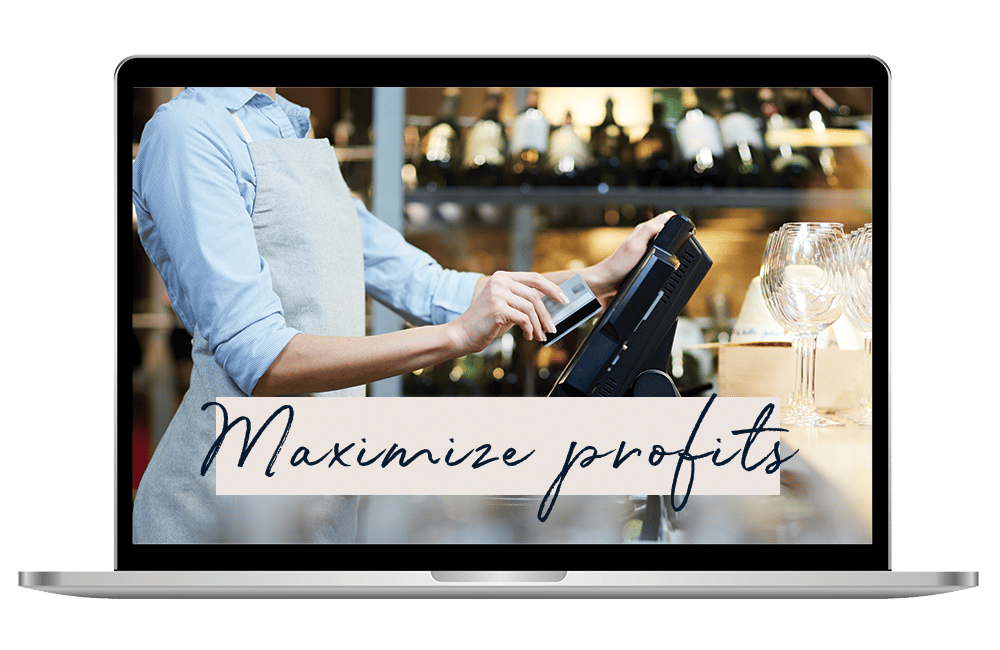
The three costly mistakes you could unknowingly be making?
Find out in this FREE guide and restaurant assessment specifically designed to reveal the unexpected hurdles standing between you and exponential business growth.
Thank You To Our Sponsors
For a limited time only, popmenu is offering our listeners $100 off your first month plus an unchanging lifetime rate.
Request a DEMO:
Did You Know That 7 out of 10 Adults Dine Out To Celebrate Birthdays?
You Can Easily Capture This Lucrative Business!
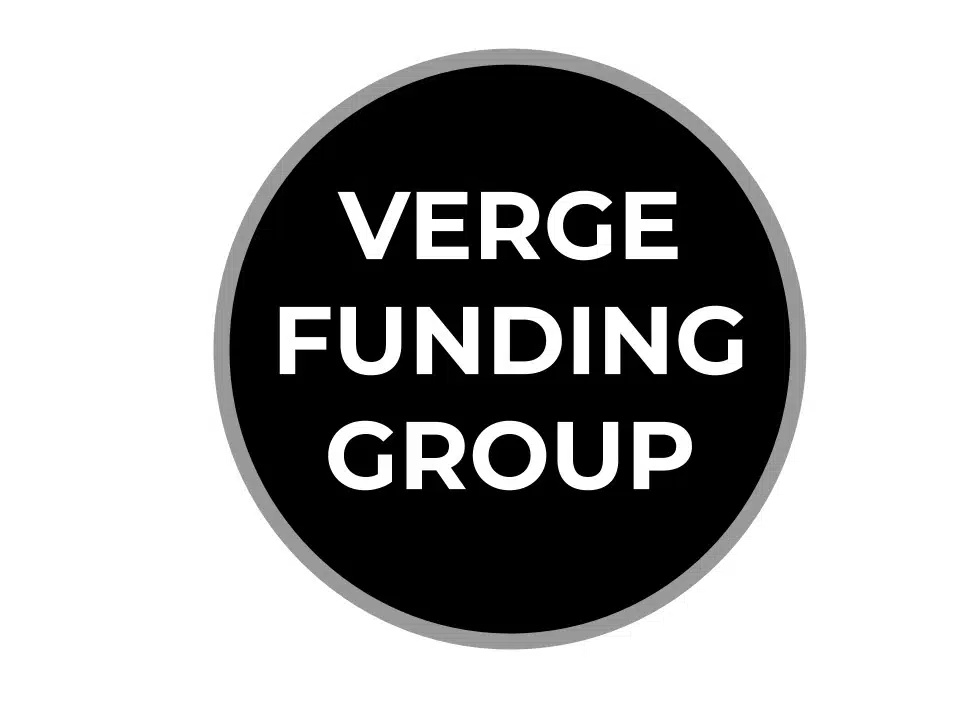
Find Out How Much Your Business Is Due Back from the ERC Program
Set Up a Call with Karen the Owner of Verge Funding
Want to become a podcast sponsor?
Please get in touch with Roger at roger@restaurantrockstars.com
